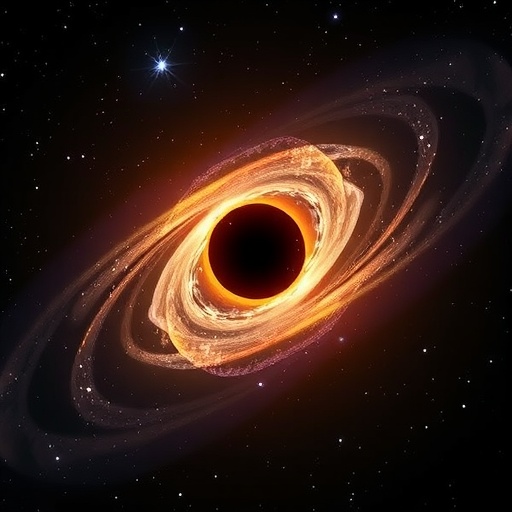Astrophysicists may soon be on the brink of a groundbreaking endeavor that transcends our current understanding of the universe. Imagine a spacecraft, flawlessly engineered and no larger than a paperclip, propelled by a beam of lasers traveling faster than the speed of light towards a black hole. Such a monumental mission could ultimately reshape our understanding of the laws of physics and the very fabric of space and time. Notably, this is not merely a whimsical fantasy but a potential reality that Cosimo Bambi, a leading astrophysicist from Fudan University in China, believes is not too far from our grasp.
In a recent commentary published in the esteemed journal iScience, Bambi presents a visionary plan to embark on an interstellar voyage like no other. This ambitious mission, while still many years away, aims to explore black holes, which are among the most enigmatic and powerful entities in the cosmos. Bambi emphasizes that with the right technological advancements within the next couple of decades, we can transform this concept into action. He elaborates, “We don’t have the technology now, but in 20 or 30 years, we might.”
Central to successful execution of this mission are two primary challenges: the identification of a black hole that is sufficiently close to Earth and the creation of spacecraft that can survive the daunting journey. Current astrophysical knowledge suggests that there is a chance of discovering a black hole located a mere 20 to 25 light-years from our planet. However, this pursuit will not be straightforward, as black holes do not produce or reflect light. Instead, they are detected based on their gravitational effects on nearby stars or their influence on the trajectory of light.
Bambi remains optimistic about advancements in detection technology, stating that new techniques developed in recent years have already made black holes more accessible to study. “It’s reasonable to expect we could find a nearby one within the next decade,” he comments, instilling a sense of hope for the field. This assertion would mark a vital step forward in astronomy, opening possibilities for deeper exploration of black holes and their fundamental characteristics.
Once a target black hole has been discovered, the next significant challenge is navigating the vast cosmic distances to reach it. Traditional spacecraft, propelled by chemical-based fuels, are ill-equipped for such ambitious journeys due to their weight and slow speeds. Instead, Bambi proposes the concept of “nanocrafts,” which are extremely small and lightweight robotic probes equipped with microchips and light sails. These nanocrafts could be launched into space and propelled by powerful ground-based lasers that would bombard the sails with photons, effectively accelerating the probes to a staggering one-third the speed of light.
Such advanced propulsion methods could theoretically enable these nanocrafts to reach a black hole located 20 to 25 light-years away in about 70 years. Coupled with the time required for data transmission back to Earth, the entire mission duration could span approximately 80 to 100 years. This duration poses significant challenges and considerations, as it surpasses the lifetime of many of today’s space missions.
Upon reaching the vicinity of the black hole, researchers would have the opportunity to conduct groundbreaking experiments aimed at addressing some of the most pressing queries in modern physics. They would investigate the existence of the event horizon, which represents the boundary beyond which no information or matter escapes the black hole’s gravitational grip. Furthermore, they would examine whether the foundational laws of physics remain consistent when subjected to the intense conditions surrounding black holes, a feat that could either validate or challenge Einstein’s theory of general relativity.
While the monumental cost of the proposed laser infrastructure is estimated at approximately one trillion euros in today’s currency, Bambi remains convinced that such ambitious technological aspirational goals are achievable. He articulates a vision aligned with historical technological leaps, exemplifying how past generations previously dismissed the feasibility of detecting gravitational waves due to their perceived weakness. Yet, a century later, such detection was made possible and revolutionized our understanding of the universe.
Bambi’s excitement for the potential of this mission is palpable. “It may sound really crazy, and in a sense closer to science fiction,” he remarks, but the continuous evolution of technology reinforces the belief in the possibility of realizing such ambitious projects. The same skepticism once faced by pioneers in the field has given way to tangible advancements that have reshaped our understanding of cosmic phenomena.
The groundwork for such endeavors is rooted in international collaboration and an unwavering dedication to pushing the boundaries of scientific inquiry. This initiative reflects the commitment of research bodies and facilities to not only explore the mysteries of black holes but also broaden the horizons of human knowledge and capability. As physicists and engineers from varied backgrounds join forces, the future of space exploration beckons potentially transformative discoveries about the universe we inhabit.
This research initiative has garnered support from the National Natural Science Foundation of China, which contributes significantly to the funding of scientific exploration. By backing bold missions such as this, funding agencies underscore the importance of investing in the future of science, encouraging innovative ideas that challenge our current understanding of reality.
In conclusion, as we stand at the threshold of extraordinary advancements in astrophysics, the possibility of sending a nanocraft to a black hole is more than an intriguing concept; it symbolizes a quest for knowledge that stretches the limits of human ingenuity. The mission envisioned by Cosimo Bambi opens the door for new realms of understanding regarding the cosmos. Each step towards its realization ignites excitement and anticipation for the breathtaking discoveries that await humanity in the forthcoming decades.
Subject of Research: Not applicable
Article Title: An interstellar mission to test astrophysical black holes
News Publication Date: 7-Aug-2025
Web References: iScience
References: 10.1016/j.isci.2025.113142
Image Credits: Credit: Event Horizon Telescope Collaboration
Keywords
Astrophysics, Black Holes, Interstellar Mission, Nanocrafts, General Relativity, Space Exploration, Physics, Technology, Cosmic Phenomena, Research Initiative.




